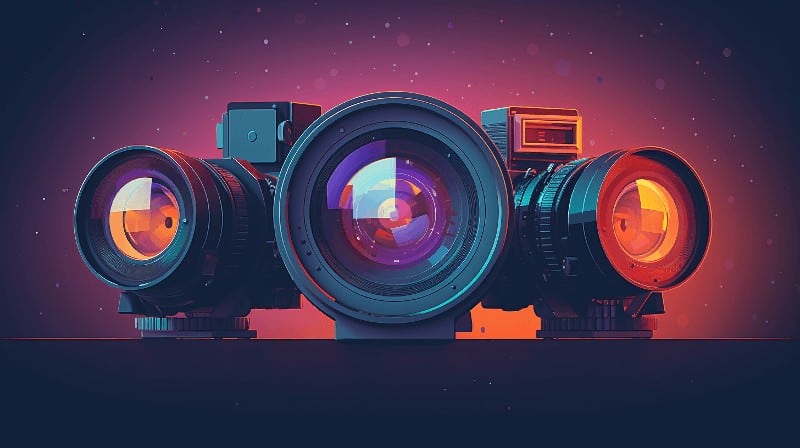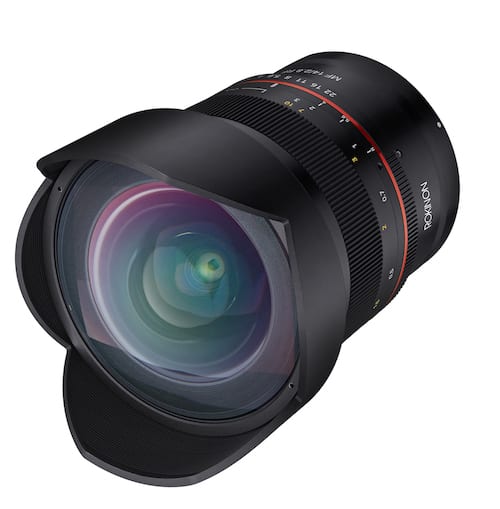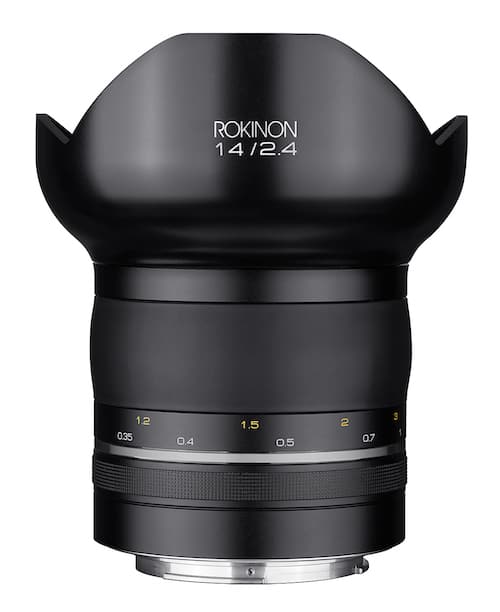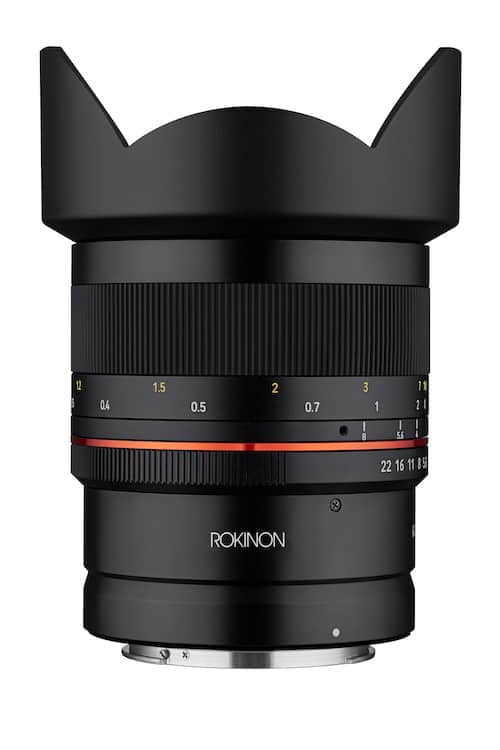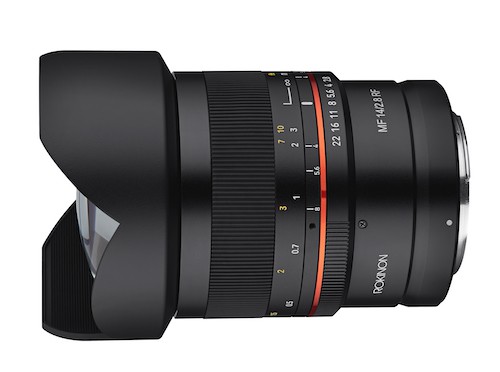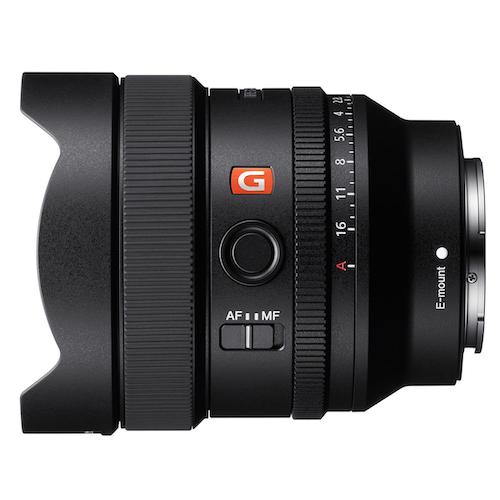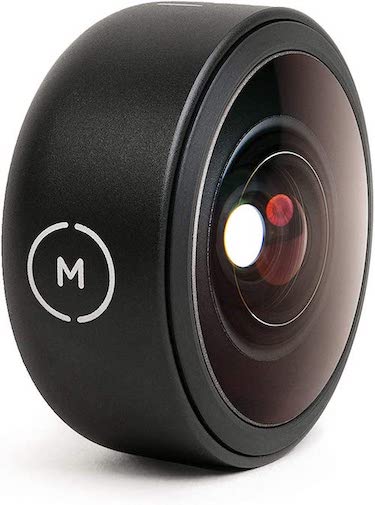14mm lenses have the perfect focal length for landscape photography and astrophotography.
In this article, we present the best 14mm lens options for different camera brands – Nikon, Canon, Sony, Pentax, Fujifilm, Olympus, plus smartphones.
Here are the quick links or read on for more detail:
— Best 14mm lens for Nikon (Budget): Rokinon 14mm f/2.8 for Nikon
— Best 14mm lens for Nikon (Premium): Sigma Art 14mm f/1.8 for Nikon
— Best 14mm lens for Canon (Budget): Rokinon 14mm f/2.8 for Canon
— Best 14mm lens for Canon (Premium): Sigma Art 14mm f/1.8 for Canon
— Best 14mm lens for Sony (Budget): Rokinon 14mm f/2.8 for Sony
— Best 14mm lens for Sony (Premium): Sony FE 14mm F1.8 GM
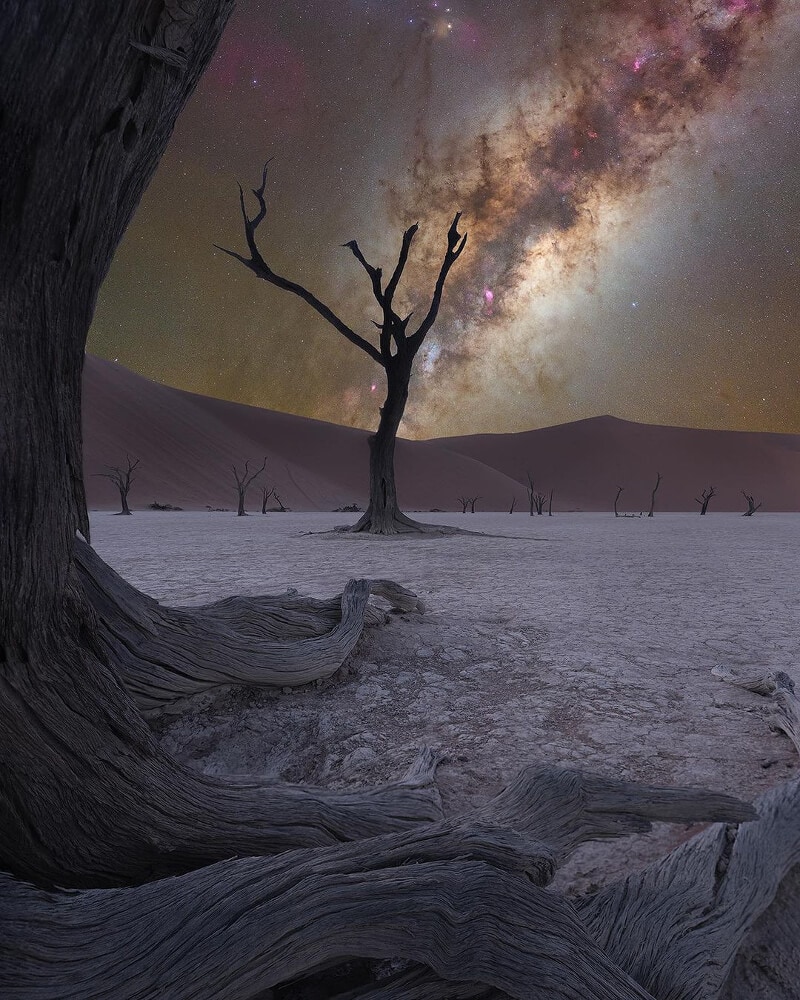
What are 14mm lenses good for?
14mm lenses are perfect for:
- Landscape astrophotography (think of those beautiful Milky Way shots), and
- Landscape photography in general.
This is because they are wide-angle, meaning that they capture a wider view of the sky or landscape that you are shooting.
In our research of what equipment was used in all images shortlisted for Astronomy Photographer of the Year 14mm lenses were the most commonly used in the landscape astrophotography categories:
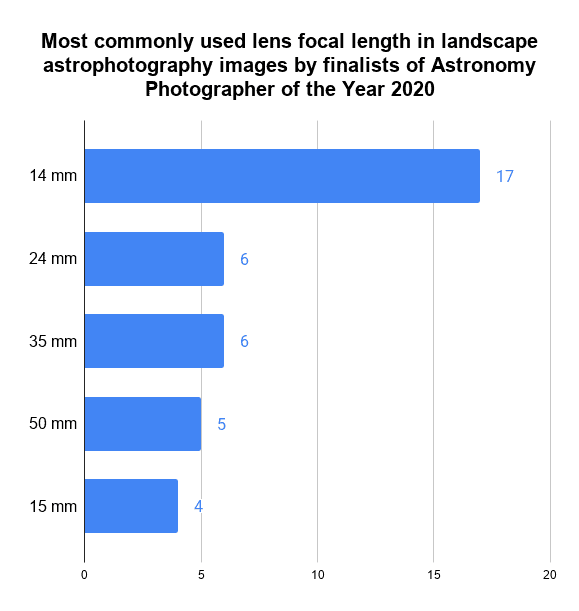
See What is the Best Focal Length for Astrophotography? for the full analysis.
This is why they are often the lens of choice for amateur astrophotographers who want to get out and photograph the Milky Way above the Earth.
Note that most of these images were taken with full-frame cameras. If using crop sensor (APS-C) cameras then the effective focal length will be 21mm. This is still a good wide-angle for most purposes, but worth noting.
Let’s now look at the best 14mm lenses for different cameras.
Best 14mm lens for Nikon
There are a number of great options for 14mm lenses for Nikon cameras.
One thing to note is what kind of Nikon camera you have, as this will make a difference on what lens is compatible. For what we are discussing here, there are essentially three types of Nikon camera:
- DX – crop sensor or APS-C type Nikon DSLR cameras have DX mounts
- FX – full-frame Nikon DSLRs have FX mounts
- Z – full-frame Nikon mirrorless cameras have Z mounts
Note that the DX lenses usually still work full-frame Nikon cameras, but they may lose some functionality (like autofocus).
There are four great options for Nikon owners:
- Rokinon/Samyang 14mm f/2.8
- Sigma 14mm f/1.8 Art
- Nikkor 14-24mm f/2.8
- Rokinon 14mm f/2.4
We’ll look at each in turn now.
Rokinon (a.k.a. Samyang) 14mm f/2.8
Firstly, the Rokinon 14mm f/2.8 lens is probably the best value 14mm lens for Nikon cameras.
At f/2.8, the fast aperture is great for night sky imaging and capable of capturing high-quality images.
It is lower (and therefore ‘slower’) than the aperture of the Sigma lens below and the f/2.4 Rokinon, but the trade-off is the price – this Rokinon lens is generally considerably cheaper and is a bit of a bargain for what you get.
One thing to note is that there are a few different versions of this lens that you can get to suit your needs:
- Manual focus vs auto focus – it depends on what you are photographing as to whether you need the autofocus. If using mainly for landscape photography and astrophotography you will probably mostly be using only the manual focus only.
- Original vs Series II – The main difference on the Series II version is that it is weather-sealed – which can be great for landscape and astrophotography – and has a function to allow you to lock the focus ring.
- For Nikon F Mount vs Nikon Z Mount – The F Mount is for Nikon full-frame DSLRs, and the Z Mount for their mirrorless models.
- Rokinon brand vs Samyang brand – Rokinon and Samyang are the same manufacturer but just have different brand names for different international markets, however, can both be bought in the US and other countries. Therefore the Rokinon 14mm f/2.8 and the Samyang 14mm f/2.8 are the same lens and so if this is what you want to go for, it is always worth checking the price of each to see what is currently the best value for you.
Specifications
- Focal length: 14mm
- Aperture: F/2.8
- Weight: 1.2 lbs
- Compatibility: DX, FX, Z Mounts
Check the links here for availability and live prices of different versions of this lens from different retailers:
- Manual focus only: Rokinon 14mm f/2.8 Manual focus for Nikon F Mount
- Manual focus only: Samyang 14mm f/2.8 Manual focus for Nikon F Mount
- With autofocus: Rokinon 14mm f/2.8 Autofocus for Nikon F Mount
- With autofocus: Samyang 14mm f/2.8 Autofocus for Nikon F Mount
- Series II: Rokinon Series II with manual focus for Nikon F Mount
- For Z mount: Rokinon Manual focus for Nikon Z Mount cameras (no adapter needed)
Sigma Art 14mm f/1.8 for Nikon
The Sigma Art is the cream of the crop when it comes to 14mm lenses and the best option for those who have the budget.
The f/1.8 aperture is extremely fast and perfect for astrophotography where this is needed for capturing the faint light from dark skies.
Here’s a great video with astrophotography Alyn Wallace demonstrating this lens:
It is compatible with all Nikon DSLR cameras. The only potential downside is the weight, which is roughly double that of the Rokinon above.
Specifications
- Focal length: 14mm
- Aperture: F/1.8
- Weight: 2.6 lbs
- Compatibility: FX & DX (Nikon DSLRs)
Nikkor 14-24mm f2.8
The third option we present is this Nikkor 14-24mm f/2.8 lens.
In comparison to the above lenses, what you get with this is greater flexibility on the focal length as it is a zoom lens. Therefore, you have the possibility to shoot at anything between 14mm and 24mm when you compose your shots. This is something that is not offered by the other prime lenses.
The aperture is the same as the Rokinon lens, so slower than the Sigma Art.
In this video, astrophotography Pete Zelinka gives a favorable review in comparison to the Rokinon 14mm f/2.8:
It can be bought for either F-mount or Z-mount Nikon cameras.
Specifications
- Focal length: 14-24mm
- Aperture: F/2.8
- Weight: 2.2 lbs
- Compatibility: FX & Z (full-frame Nikon DSLRs & Mirrorless cameras)
Rokinon SP 14mm F/2.4
Brand new is the Rokinon Special Performance 14mm f/2.4 lens for Nikon F mount cameras.
This manual focus lens has faster aperture than the Rokinon f/2.8 model above. This brings it closer in competition with the Sigma f/1.8 lens and will help it perform better under dark skies.
It also boasts a sleeker design and a light weight.
Specifications
- Focal length: 14mm
- Aperture: F/2.4
- Weight: 1.6 lbs
- Compatibility: FX & DX (Nikon DSLRs)
Best 14mm lens for Canon
With Canon camera lenses, the main thing you need to watch for is whether the lens is for an EF or RF mount. The definition is:
- EF is regular Canon DSLRs, like the Canon EOS 5D, etc
- RF is for Canon full-frame mirrorless models, like the Canon EOS R, etc
The models we will look at here are:
- Rokinon 14mm F/2.8 for Canon DSLRs
- Rokinon 14mm F/2.8 for Canon Mirrorless cameras
- Sigma 14mm F/1.8 for Canon DSLRs
- Rokinon 14mm F/2.4 for Canon DSLRs
Rokinon 14mm f/2.8 for Canon EF mount (DSLR)
As detailed above, the Rokinon 14mm f/2.8 lens is the best value option and is available for Canon cameras.
This model is for Canon EF mount DSLRs (see below for Canon’s mirrorless cameras).
This a brilliant budget lens for astrophotography and it’s hard to find comparable quality for the price.
Remember to compare the prices for this under the Rokinon and Samyang names as they are the same lens.
Specifications
- Focal length: 14mm
- Aperture: F/2.8
- Weight: 1.1 lbs
- Compatibility: EF (Canon DSLRs)
Rokinon 14mm f/2.8 for Canon RF mount (mirrorless)
This is the same lens as above but released in late 2019 for Canon RF mount full-frame mirrorless cameras.
This makes it one of the only options at 14mm for Canon mirrorless cameras and provides great value.
There is no adapter needed like there would be if you were to use a non-RF mount-specific lens, and it’s considerably cheaper than most lens options available for Canon mirrorless cameras at the moment.
Specifications
- Focal length: 14mm
- Aperture: F/2.8
- Weight: 1.6 lbs
- Compatibility: RF (Canon mirrorless cameras)
Sigma Art 14mm f/1.8 for Canon
The Sigma Art 14mm is also available for Canon EF mount DSLR cameras.
For more detail, see under Nikon above as the specs and details are the same.
A comparable lens is the Canon 14mm f/2.8 but that is slower, older, and usually more expensive so it doesn’t make sense to opt for that. Instead, go for either budget value (Rokinon) or the very best in this Sigma model.
Specifications
- Focal length: 14mm
- Aperture: F/1.8
- Weight: 2.6 lbs
- Compatibility: EF (Canon DSLRs)
Rokinon SP 14mm F/2.4
Also available is the Rokinon SP (Special Performance) 14mm f/2.4 lens for Canon EF mount DSLR cameras.
This manual focus lens has a faster aperture than the Rokinon f/2.8 and this brings it closer to the Sigma f/1.8 lens and will help it perform better in low light.
It also boasts a sleek design and a lightweight.
Specifications
- Focal length: 14mm
- Aperture: F/2.4
- Weight: 1.75 lbs
- Compatibility: EF (Canon DSLRs)
Best 14mm lens for Sony
Sony E mount lenses work for all their full-frame mirrorless cameras.
The best options are:
- Rokinon 14mm f/2.8
- Sigma 14mm f/1.8
- Sony 14mm f/1.8
Rokinon 14mm f/2.8 for Sony
As detailed above, the Rokinon 14mm f/2.8 lens is the best value option and is available for Sony mirrorless cameras.
Remember to compare the prices for this under the Rokinon and Samyang names.
Specifications
- Focal length: 14mm
- Aperture: F/2.8
- Weight: 1.75 lbs
- Compatibility: Sony E mount
Sigma Art 14mm f/1.8 for Sony
The Sigma Art 14mm is available for Sony E-mount mirrorless cameras.
It has the same high-quality performance that this lens has had for years which made it a favorite for DSLR owners, and now for mirrorless models too.
As noted earlier for Nikon/Canon, the only real downside is the weight, which can be an issue if taken out on hikes, etc. This is where you might want to compare it to the Sony lens below and make a choice between these two if you have the budget.
Specifications
- Focal length: 14mm
- Aperture: F/1.8
- Weight: 2.6 lbs
- Compatibility: Sony E mount
Sony FE 14mm F1.8 GM Lens
Sony has their own 14mm f/1.8 lens for E-mount Sony cameras which was released brand new in 2021.
Similar in spec to the Sigma lens above, but boasting an ultra-lightweight of just 1 lb – less than half that of the Sigma. It can be used in autofocus and manual mode.
Here’s a recent review to give a good overview:
Specifications
- Focal length: 14mm
- Aperture: F/1.8
- Weight: 1 lb
- Compatibility: Sony E mount
Best 14mm lens for Pentax
For Pentax cameras, it’s an easy choice for 14mm lenses as you have one option for full-frame Pentax DSLRs and one option for Pentax crop sensor DSLRs:
- Rokinon / Samyang 14mm f/2.8 – for full-frame Pentax K mount full-frame DSLRs
- Pentax 14mm f2.8 – for APS-C sensor Pentax DSLRs
Rokinon 14mm f/2.8 for Pentax
The Rokinon 14mm f/2.8 lens is available for Pentax K mount full-frame DSLR cameras.
It is a great lens for astrophotography and would fit perfectly with the Pentax K1 Mark II (see the Best Pentax Cameras for Astrophotography).
Remember to compare the prices for this under the Rokinon and Samyang names as they are the same lens:
Specifications
- Focal length: 14mm
- Aperture: F/2.8
- Weight: 1.2 lbs
- Compatibility: Pentax K Mount
Pentax 14mm f/2.8
The alternative option for Pentax camera users is this Pentax 14mm f/2.8 lens that is for APS-C crop sensor Pentax DSLRs.
The f/2.8 aperture is fast and this lens should work well for astrophotography if combined with a camera like the Pentax K-70.
Specifications
- Focal length: 14mm
- Aperture: F/2.8
- Weight: 0.9 lbs
- Compatibility: Pentax APS-C
Best 14mm lens for Fujifilm
There are two options for 14mm lenses for Fujifilm cameras:
- Rokinon / Samyang 14mm f/2.8
- Fujinon 14mm f/2.8
Rokinon 14mm f/2.8 for Fujifilm
As detailed above, the Rokinon 14mm f/2.8 lens is a great value option and is available for Fujifilm cameras.
Remember to compare the prices for this under the Rokinon and Samyang names as they are the same lens.
Specifications
- Focal length: 14mm
- Aperture: F/2.8
- Weight: 1.2 lbs
- Compatibility: Fujifilm X mount
Fujinon XF 14mm F2.8 R
The alternative option for Fujifilm camera users is this Fujinon 14mm f/2.8 lens.
It is ultra-light at just 0.5 lbs.
Specifications
- Focal length: 14mm
- Aperture: F/2.8
- Weight: 0.5 lbs
- Compatibility: Fujifilm X mount
Best 14mm lens for Olympus
There are two options for 14mm lenses for Fujifilm cameras:
- Rokinon / Samyang 14mm f/2.8
- Olympus M.Zuiko 7-14mm f/2.8
Rokinon 14mm f/2.8 for Olympus
As detailed above, the Rokinon 14mm f/2.8 lens is the best value option and is available for Olympus cameras.
Remember to compare the prices for this under the Rokinon and Samyang names as they are the same lens.
Specifications
- Focal length: 14mm
- Aperture: F/2.8
- Weight: 1.2 lbs
- Compatibility: Olympus Micro Four Thirds cameras
Olympus M.Zuiko 7-14mm F2.8
The alternative option for Olympus micro 4/3 camera users is this Olympus 7-14mm f/2.8 lens.
This is a zoom lens that goes as wide as 7mm and up to 14mm – since this is for Micro 4/3 sensor cameras this is the equivalent of 14mm-28mm on a full-frame camera.
Specifications
- Focal length: 7-14mm
- Aperture: F/2.8
- Weight: 1.2 lbs
- Compatibility: Olympus Micro Four Thirds cameras
Best 14mm Lens for Smartphones
You can also get attachment lenses at 14mm for smartphones that give you extra wide-angle focal length.
Moment 14mm Fisheye Lens for Smartphones
The Moment 14mm fisheye lens is a cool add-on for your smartphone
Compatible with most iPhone, Google, and Samsung smartphones and tablets, this lens gives you similar optics to that seen with GoPro cameras – ultra wide-angle.
You can watch a good video overview of this lens from Moment here:
Best 14mm Lenses: FAQs
What do the lens specifications mean?
Focal length
The ’14mm’ refers to the focal length of the lens. The lower this number is, the wider it is.
High focal lengths (for example, 100mm) capture much narrower images but enable you to zoom in closer. This can be good for photographing objects like the moon or the planets of the solar system.
Aperture
The other specification to pay attention to is the aperture. This is the ‘f number’ you see named in the lens model.
Essentially the lower this number is, the faster the aperture and the better the lens is at capturing light. This is especially important for night photography.
This is why the lenses featured in this article have fast apertures of around f/1.8 to f/2.8.
Remember higher aperture = lower f-number = greater light-gathering capacity!
Is there a 14mm lens for Nikon Z-mount mirrorless cameras?
Yes, there are two good 14mm lenses for Nikon Z mount cameras:
Are prime or zoom lenses best?
Generally, prime lenses offer better image quality but are fixed at a certain focal length.
Zoom lenses offer greater flexibility but sometimes at the cost of picture quality.
What is the best lens for astrophotography?
See our full overview here of the Best Lens for Astrophotography
Over to you – what’s the best 14mm lens?
We hope this was useful for you if you are looking for a good 14mm lens.
We’ve taken an astrophotography-focused approach and so have favored higher aperture lenses for their greater light-gathering abilities.
If you have any other lens suggestions or other questions, please leave them in the comments below.


